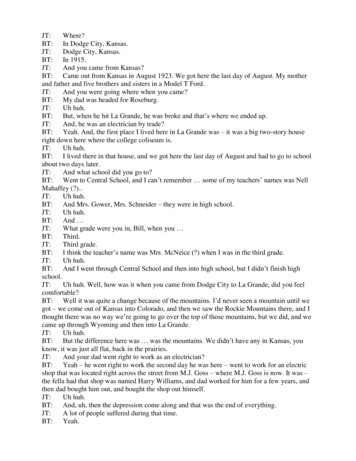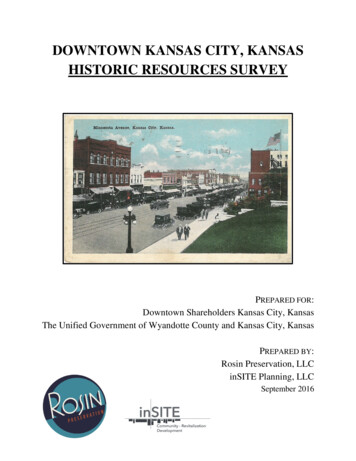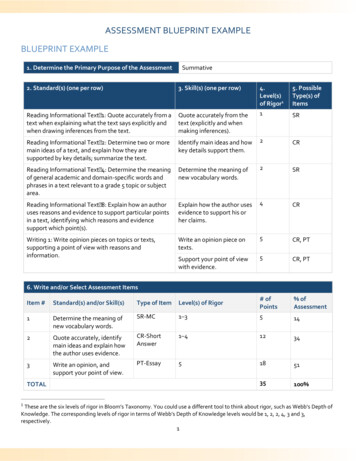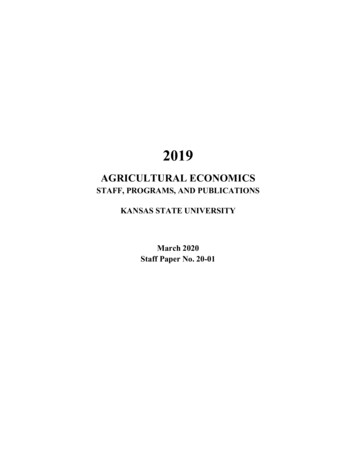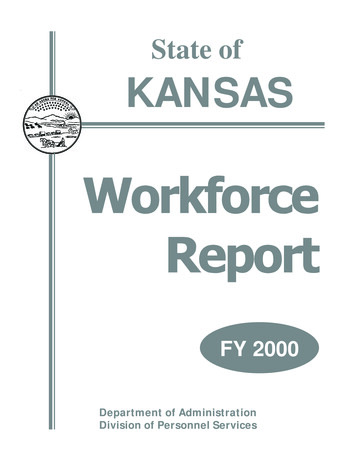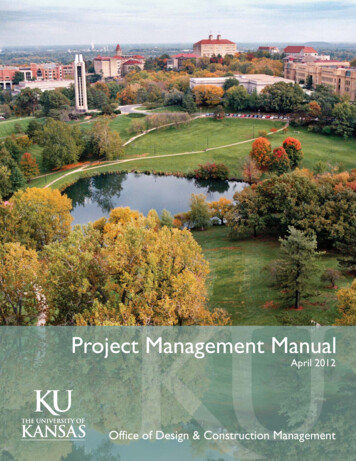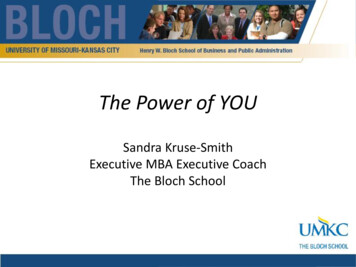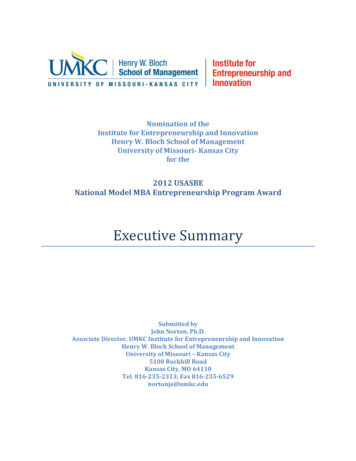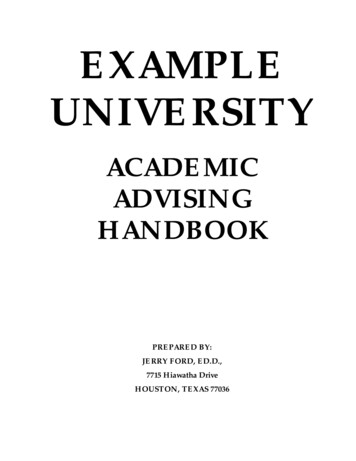
Transcription
EXAMPLEUNIVERSITYACADEMICADVISINGHANDBOOKPREPARED BY:JERRY FORD, ED.D.,7715 Hiawatha DriveHOUSTON, TEXAS 77036
TABLE OF CONTENTSPage1Letter from the Dean of the General Studies CollegeSection One - Academic AdvisingResearch Data355668111516Academic AdvisementIntroductionAssumptionsDefinitionsThe Faculty Advisor's RoleFunctions of the Faculty AdvisorLimitations of Faculty Advisors/AdvisingConclusion/Student BenefitsSection Two - Academic AdvisingResource MaterialsThe Advising ProcessThe Do's of Academic AdvisingP. T. Barnum’s Business RulesThe Don'ts of Academic AdvisingThe Stereotypes of Faculty AdvisementStrategies of AdvisementTraditional "Good Advisor Descriptors--Some ObservationsWhat Is a Student?Responsibilities of the AdvisorAdvisor BehaviorsInterpersonal Advisor BehaviorsAcademic Advisor BehaviorsCharacteristics of a Good AdvisorThe Devil's (Advocate) List for Good-Advisor CharacteristicsLegal Issues and Academic AdvisingContractual RelationshipThe Buckley Amendment: Advisor's Responsibilities and Student's Right to PrivacyPrivileged CommunicationAcademic Due ProcessLegal Issues and The Family Educational Rights and Privacy ActBackgroundApplicabilityDefinitionsRights of Inspection and ReviewDisclosurePolicy RequirementsEnforcementReferral Skills SummaryHow to Refer StudentsThirty Reminders for Effective 242424244454646474749
Responsibilities of AdviseesAcademic Advising--How You and Your Faculty Advisor Should Work TogetherWhen to See Your AdvisorHow to See Your AdvisorWhat You and Your Advisor Should DoGuidelines for Advisees—Get the Best Out of AdvisorsStudy SkillsStudy Tips for the LearnerSuggestions for Improving Written WorkPractices for Better Research ProjectsGuidelines for Reviewing Material and Taking TestsStudy Tips--Listening SkillsHow To Be a Good ListenerStudy Tips--Taking Lecture NotesThree Reasons for Taking Good Lecture NotesFour Rules for Improving the Listening ProcessThree Forms for Taking Lecture NotesThree Rules for Reviewing Lecture NotesSometimes a Few Simple Rules Can Uncomplicate MattersStudy Tips--Time PlanningA Time ToStudy Tips--Time Planning and TardinessAdvisee ProblemsAcademic Difficulty--Analysis FormAcademic Difficulty--The Low-Achieving Advisee: A Self-Inquiry Routine for AdvisorsAcademic Difficulty--Advising Students Who Have Personal ProblemsActive Listening SkillsIndicators of When to be ConcernedUnusual BehaviorTraumatic Changes inPersonal RelationshipsDrug and Alcohol AbuseAcademic ProblemsCareer Choice ProblemsWhen to ReferHow to ReferTo Sum it upAcademic Difficulty--Student MisbehaviorAcademic Difficulty--Students On Academic ProbationThe Role of the Faculty AdvisorCareer Development--Thoughts to ConsiderWhat Can I do With This Degree?Agriculture and Natural ResourcesArtBiological SciencesBotanyBusinessChemistryChild and Family StudiesCommunications/JournalismComputer 17173737576768082828588939698101104107109112115
ality/Hotel, Restaurant ical Science and GovernmentPsychologySociologySection Three--Academic AdvisingAt Example UniversityRegulations and ResponsibilitiesAcademic Advising Objectives Example UniversityAdvisor Contacts and Responsibilities –Fall, Winter, Spring, and SummerIndividual Student AdvisementMinimum ContactsQuarterly ContactsAdvisor Responsibilities: What Should Advisors beExpected to do at Example U?Athletes--Academic AdvisingMinimum Academic RequirementsScholastic StandardsSchedule and Attending ClassesCareer Services--An IntroductionConvocation PoliciesEducation Majors and Teacher Certification CandidatesEnglish Placement GuidelinesEnglish Placement--The Writing LabEnglish Placement--The Writing Lab: MemorandumEvening Program: One-year Schedule for General StudiesFinancial Aid Process at Example UniversityApplication of FundsSelectionDelivery SystemParameters and DiscussionTypical Aid ReceivedForeign Languages--General InformationGeneral Electives--Advanced LevelInterdisciplinary Courses (INDC)International Students--Intensive English InstituteInternational Students--Notes to AdvisorsInternational Students--Rules for F-1 StudentsMathematics and Science PlacementMusic--Advising BA/BS CandidatesMusic--Advising BM CandidatesMusic—Example University's Choral EnsemblesMusic—Example University's Instrumental EnsemblesReligion PlacementReminder--Are You a Good Advisor?Reminder--Measuring 9180181183184185186187188189
BibliographyAppendixesA. English and Foreign Languages Advising TableB. Business, Religion, and History Advising TableC. Mathematics and Science Advising TableD. Advanced Standing Advising TableE. Registration QuestionsF. Grade QuestionsG. Referrals191197199201203205209211213GOOD ADVICE!“IF I’D TALKED TO AN ADVISERINSTEAD OF JUST MY FRIENDS ICOULD HAVE SAVED ABOUT 5,000AND A LOT OF GRIEF. BETWEENTHE CLASSES I TOOK THAT IDIDN’T NEED AND THE SEMESTERI ADDED BY MISSING THEAPPLICATION DATE TO MY MAJOR,A FEW VISITS TO THE ADVISINGOFFICE WOULD HAVE REALLY PAIDOFF” (Tyler, 1997, p. 62).Benjamin Franklin declared, “we can give advice, but weCannot give conduct. Remember this: they that will not becounseled cannot be helped” (“The Way of Advice,” 1991, p. 1).iv
EXAMPLE UNIVERSITYOffice of the DeanCollege of General StudiesSomewhere, USADear Advisor:The new edition of the Example University Academic Advising Handbook has been developed toassist you in your role as an advisor. It has been designed to serve as a quick reference for usefuland pertinent information.Your new handbook is divided into three sections. The first section contains research dataconcerning academic advising. Included are definitions of advising, roles and functions of academicadvisors, behavioral objectives, and limitations of academic advising.Section Two of the handbook is a collection of various lists, resource materials, and articles that youmay utilize in advising situations. The resource materials found in Section Two are subdivided intofour categories. Those categories are "The Advising Process," "Responsibilities of the Advisor,""Responsibilities of Advisees," and "Advisee Problems." This section should contribute to yourunderstanding of your task as a faculty advisor and your importance in the total educational goals ofExample University.The third section contains information pertaining to specific departments and to specific ExampleUniversity regulations. Specifically included is a set of "Advisor Contacts and Responsibilities,"which should be very helpful to you in directing your quarter by quarter advising activities. It isimperative that you become familiar with section three.You are encouraged to read your handbook very carefully, to refer to it often, and to utilize itcompletely as you advise your students. Make your role as an advisor more than a signature on aregistration process form. Using your handbook and other available resources, you can make youradvisees' educational experiences more meaningful and significant.If you have comments, questions, or suggestions, please share them with me.Sincerely,Joseph Doe, ED.D., DeanCollege of General StudiesJF/jf
SECTION ONEACADEMIC ADVISINGRESEARCH DATA
ACADEMIC ADVISEMENT"ONE OF THE MAIN RESPONSIBILITIES OF ANYINSTITUTION OF HIGHER EDUCATION INVOLVESACADEMIC ADVISEMENT OF STUDENTS" (Ward, 1979, p. 1).INTRODUCTIONIn most institutions of higher education, faculty members are required to assume the role ofacademic advisor (Dressel, 1974, p. 57). Until recently, faculty advising had received relatively littleor no attention in the literature or on individual campuses even though systems of academic advisinginvolve hundreds of thousands of students, faculty, and paraprofessionals (Raskin, 1979, p. 99). Inaddition, multiplied millions of dollars in both faculty time and physical facilities are required tosupport and conduct the activity known as academic advising (Bonar, 1976a, p. 190). Greaterinterest in advising has developed because of the growing complexity of higher educationinstitutions, because of the ever increasing threat of declining enrollment, and because of thediversity of the students enrolling in the universities. Once viewed as a set of scheduling procedures,academic advising programs have been established to assist students in the development of theirhuman potential (Abel, 1980, p. 151).5
ASSUMPTIONSUniversal practice in higher education has students assigned to faculty members in thedisciplines in which the students are majoring. Too frequently, however, faculty advisors must workwith students who are undecided about a major. The general assumption is that faculty advisors willbe able to guide their advisees toward each advisee's collegiate goal--to be graduated within thenormal span of four or five academic years (Dressel, 1974, p. 57).Academic advising systems utilizing the university faculty are based on several assumptions:1.Faculty members are interested in one-to-one situations with students.2.Faculty members are the most appropriate persons to guide students incourse selections.3.Faculty members are knowledgeable enough to help students through a mazeof degree requirements.4.Utilizing faculty members is the most financially feasible way of providingacademic advising.5.Students want advice from faculty members concerning each student'sspecific academic program (Dressel, 1974, p. 57).DEFINITIONSIt is obvious from perusing the five basic assumptions previously stated that facultymembers in the role of academic advisors are essential components for any successful academicadvisement program. Perhaps at this point the question should be asked, "What is a facultyadvisor?" The American Association of Collegiate Registrars and Admissions Officers has statedthat an advisor is "A member of the college staff (usually a member of the instructional faculty)assigned to assist a student with academic planning" (Definitions of Terms for Admissions andRecords, 1980, p. 8).Labeling the faculty advisor the "University Adviser," the Committee on Advising andCounseling at Stanford University asserts that:6
The University Adviser is the student's principal faculty adviser. His primeconcern with the student, and the student's with him, is the identification of thestudent's aims and plans, his interest and abilities, and the planning of a coherenteducation that builds upon the student's interest and allows him perspective on andawareness of both his limitations and his strengths. The adviser does not plan forthe student but helps the student to plan for himself (Study of Education atStanford, 1969, p. 19).The Stanford Committee defines the advisor as ".the student's academic advocate, theparticular educator who agrees to concern himself with his advisee's best education." In theCommittee's view, "The Adviser is not to be interested merely in obedience to regulations but is topursue with the student the education that best serves and develops that student" (Study ofEducation at Stanford, 1969, p. 27).Every student, regardless of the type and size of higher education institution, has occasion tobe seen in a counseling relationship by a faculty member, known as the faculty advisor, specificallyqualified to assist in decisions concerning academic majors and courses of study. The faculty advisorneeds to be aware of the general programs of the institution and, more specifically, the courseswithin his academic division (Shaffer and Martinson, 1966, p. 46). However, The Advisor'sHandbook of San Jose State University emphasizes that "an academic advisor does more than offeradvice on academic program planning." It continues that "an academic advisor is that representativeof an academic department or program to whom a student can turn for the personal assistance thatoften accompanies the central activity of the university--instruction" (1980, p. 2).The definition for faculty advisor at Stephens College indicates that:.every faculty member and professional administrator.assume counselingresponsibilities for a group of eight to twelve students. Each adviser is expected todeal with academic, career, and emotional problems, and he has training to qualifyhim to do so (Mayhew and Ford, 1973, p. 51).Crocket (1978a) contends that the faculty advisor serves as a coordinator of the advisee'seducational experience. The advisor needs the ability to help students define and develop realisticgoals, to perceive their needs accurately, and to match these needs with appropriate institutionalresources. A caring and trusting relationship is essential.7
It has been stated that the faculty advisor is more than an information and traffic-controlofficer. The advisor "conveys to the student a philosophy of contemporary education, a rationalbase for the consideration of problems, and suggests plans of action on which he may move"(Hardee and Mayhew, 1970, p. 21). The faculty advisor is a faculty member who gives advice to thestudent, usually on matters directly concerned with course work and academic programs(Bornheimer, et al. 1973, p. 53).THE FACULTY ADVISOR'S ROLEThe faculty advisor is generally a member of the university faculty who has been assigned tothe role or who has responded favorably to an invitation to serve as an advisor (Bloland, 1967, p. 8).The role of the faculty advisor has been described by Hardee and Mayhew in the following ways:1.The adviser will assist the student in effecting a program of study consonantwith the latter's interests and competencies.2.The adviser will assist the student in periodic evaluation of his academicprogress.3.The adviser will assist the student in initial exploration of long rangeoccupational and professional plans, referring him to sources for specializedassistance.4.The adviser will serve as coordinator of the learning experiences of thestudent, assisting in the integration of the various kinds of assistancerendered--health and psychological aids, remedial work, financial aids,religious counseling--the panoply of all services available to the students(1970, p. 11).To facilitate the foregoing role descriptions, the advisor should have considerable knowledgeof the institution's combined educational offerings, including the total available classes, extra classes,special topics classes, independent study classes, laboratories, clinics, and field experiences. It isessential for the faculty advisor to have a comprehensive knowledge of the curriculum. In addition,the advisor should be familiar with the college campus in its many structural parts; should recognizethe prevailing learning climate on campus; and should have acquired, or be in the process of8
acquiring, adequate skills for communicating with various students in authentic, appropriate, andmeaningful ways (Hardee and Mayhew, 1970, p. 11).Agreeing with Hardee and Mayhew, Higbee (1979) asserts that the role of academic advisorhas many facets. Advisors must be knowledgeable and up-to-date on matters concerning (1)curriculum--requirements in the student's majors, as well as general education and graduationrequirements of the university; (2) registration procedures; (3) student personnel services--medical,counseling, housing, placement, social, recreational, etc.; (4) financial obligations; and (5) job marketand employment information. Higbee (1979) also contends that faculty advisors must know themechanics of adding and dropping classes; changing majors; transferring from one university,college, or department to another; evaluating transfer credit or courses; petitioning for gradechanges; interpreting grade point average computations; and keeping accurate records of eachstudent's progress.The advisor's role as described in The Advisor's Handbook of San Jose State Universityincludes being the student's academic navigator. Since the advisor is the advisee's primary link to theacademic programs of the university, the advisor should be ".the person to whom the studentshould want to turn for serious, considered advice on academic questions." The advisor and adviseeare in actuality "co-navigators" because many basic decisions about an academic program must bemade by the student, utilizing input from the advisor. The role as academic navigator involvesoffering suggestions, questions, criticisms, praise, direction, and any other comments which will helpeach advisee define and achieve educational goals (1980, p. 2).In addition, it often happens that advisees and advisors become so closely acquainted thatthe advisor knows advisees intellectually, emotionally, and sometimes socially as well. These areproducts of a productive, equally shared advisor-advisee relationship. Of course, it is not theadvisor's duty to act as pal or psychological confidant, but at times the advisee may come to theadvisor seeking other kinds of counsel besides the purely academic. The alert advisor shouldanticipate such "probes" and be prepared to respond to them because the student's academic life can9
flourish only if it is relatively healthy in other ways, as well as academic (The Advisor's Handbook,San Jose State University, 1980, p. 2).Another role of the faculty advisor is being the student's advocate. Higbee (1979) refers tothis role as "A large order!" because the advisor is ".expected to show a sincere interest in thestudent, become aware of the student's interests and abilities, and be the student's advocate withinthe department and the university" (1979, pp. 47-48).Hardee (1961) has written that the role of faculty advising is a tri-dimensional activity,consisting of : (1) discerning the purposes of the institution; (2) perceiving the purposes of thestudent learner; and (3) postulating the possibilities for the student as a learner and promoting theseas means are available.The first dimension, discerning the purposes of the university, requires a knowledge ofinstitutional aims. Within these aims, the goals of general and professional education must beunderstood. Part of the knowledge to be acquired by advisors is how the content of the individualcourses and the method for their teaching produce overall learning. The advisors' search for thelearning climate in their respective institutions involves the image the university has for prospectiveand present students--the texture of the campus, its feeling, and its spirit.The second dimension, understanding the purposes of the student, is closely related to thefirst dimension when one considers the fact that students of a given nature generally gravitatetoward the institution which will fit their needs, their abilities, and their family and culturalinfluences.The third dimension, postulating the possibilities for the student as a learner and promotingthese, requires cooperation with and from the student. Hardee (1961) states that "It is the ultimatein the advising role." The perceptive advisor facilitates the student's growth in wisdom, in theappreciation for and exercise of knowledge, and in the overall integration of learning (1961, p. 116).Advisors need to weigh their reactions and approaches to each individual advisee with one majorpurpose in mind: to enrich and enhance the advisee's academic pursuits and development. This canbe accomplished ".by knowing the student's propensities and responding to them with opinions10
and help--always when asked, often when not asked" (The Advisor's Handbook, San Jose StateUniversity, 1980, p. 2).Kramer and Gardner (1983) indicate that academic advising is a continuing process withsporadic contact between two individual parties. The role of the faculty advisor and the process ofadvising may be described by an analogy: the student advisee is climbing a ladder called highereducation, mat
Office of the Dean College of General Studies Somewhere, USA Dear Advisor: The new edition of the Example University Academic Advising Handbook has been developed to assist you in your role as an advisor. It has been designed to serve a
